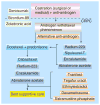Androgen receptor and immune inflammation in benign prostatic hyperplasia and prostate cancer
- PMID: 26594314
- PMCID: PMC4652646
- DOI: 10.4155/cli.14.77
Androgen receptor and immune inflammation in benign prostatic hyperplasia and prostate cancer
Abstract
Both benign prostatic hyperplasia (BPH) and prostate cancer (PCa) are frequent diseases in middle-aged to elderly men worldwide. While both diseases are linked to abnormal growth of the prostate, the epidemiological and pathological features of these two prostate diseases are different. BPH nodules typically arise from the transitional zone, and, in contrast, PCa arises from the peripheral zone. Androgen deprivation therapy alone may not be sufficient to cure these two prostatic diseases due to its undesirable side effects. The alteration of androgen receptor-mediated inflammatory signals from infiltrating immune cells and prostate stromal/epithelial cells may play key roles in those unwanted events. Herein, this review will focus on the roles of androgen/androgen receptor signals in the inflammation-induced progression of BPH and PCa.
Keywords: androgen receptor; benign prostate hyperplasia; immune inflammation; metastasis; prostate cancer.
Figures



References
-
- Hoke GP, McWilliams GW. Epidemiology of benign prostatic hyperplasia and comorbidities in racial and ethnic minority populations. Am J Med. 2008;121(8 Suppl 2):S3–S10. - PubMed
-
- Martinez M, Maislos S, Rayford W. How to engage the Latino or African American patient with benign prostatic hyperplasia: crossing socioeconomic and cultural barriers. Am J Med. 2008;121(8 Suppl 2):S11–S17. - PubMed
-
- Colon I, Payne RE. Benign prostatic hyperplasia and lower urinary tract symptoms in African Americans and Latinos: treatment in the context of common comorbidities. Am J Med. 2008;121(8 Suppl 2):S18–S26. - PubMed
Grants and funding
LinkOut - more resources
Full Text Sources
Other Literature Sources
